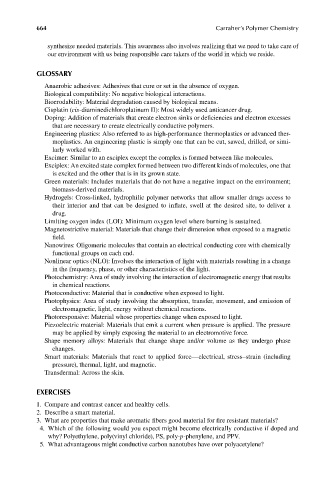Page 701 - Carrahers_Polymer_Chemistry,_Eighth_Edition
P. 701
664 Carraher’s Polymer Chemistry
synthesize needed materials. This awareness also involves realizing that we need to take care of
our environment with us being responsible care takers of the world in which we reside.
GLOSSARY
Anaerobic adhesives: Adhesives that cure or set in the absence of oxygen.
Biological compatibility: No negative biological interactions.
Bioerodability: Material degradation caused by biological means.
Cisplatin (cis-diaminedichloroplatinum II): Most widely used anticancer drug.
Doping: Addition of materials that create electron sinks or deficiencies and electron excesses
that are necessary to create electrically conductive polymers.
Engineering plastics: Also referred to as high-performance thermoplastics or advanced ther-
moplastics. An engineering plastic is simply one that can be cut, sawed, drilled, or simi-
larly worked with.
Excimer: Similar to an exciplex except the complex is formed between like molecules.
Exciplex: An excited state complex formed between two different kinds of molecules, one that
is excited and the other that is in its grown state.
Green materials: Includes materials that do not have a negative impact on the environment;
biomass-derived materials.
Hydrogels: Cross-linked, hydrophilic polymer networks that allow smaller drugs access to
their interior and that can be designed to inflate, swell at the desired site, to deliver a
drug.
Limiting oxygen index (LOI): Minimum oxygen level where burning is sustained.
Magnetostrictive material: Materials that change their dimension when exposed to a magnetic
fi eld.
Nanowires: Oligomeric molecules that contain an electrical conducting core with chemically
functional groups on each end.
Nonlinear optics (NLO): Involves the interaction of light with materials resulting in a change
in the frequency, phase, or other characteristics of the light.
Photochemistry: Area of study involving the interaction of electromagnetic energy that results
in chemical reactions.
Photoconductive: Material that is conductive when exposed to light.
Photophysics: Area of study involving the absorption, transfer, movement, and emission of
electromagnetic, light, energy without chemical reactions.
Photoresponsive: Material whose properties change when exposed to light.
Piezoelectric material: Materials that emit a current when pressure is applied. The pressure
may be applied by simply exposing the material to an electromotive force.
Shape memory alloys: Materials that change shape and/or volume as they undergo phase
changes.
Smart materials: Materials that react to applied force—electrical, stress–strain (including
pressure), thermal, light, and magnetic.
Transdermal: Across the skin.
EXERCISES
1. Compare and contrast cancer and healthy cells.
2. Describe a smart material.
3. What are properties that make aromatic fibers good material for fire resistant materials?
4. Which of the following would you expect might become electrically conductive if doped and
why? Polyethylene, poly(vinyl chloride), PS, poly-p-phenylene, and PPV.
5. What advantageous might conductive carbon nanotubes have over polyacetylene?
9/14/2010 3:44:10 PM
K10478.indb 664
K10478.indb 664 9/14/2010 3:44:10 PM

